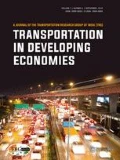Abstract
With increasing traffic at intersections, it becomes essential to install traffic control devices to regulate the movements. These controlled intersections are known as “Signalized Intersections”. When the vehicles are waiting for their turn to clear the signalized intersection, the drivers normally do not keep the engines off and this results in extra fuel consumption due to idling and increased vehicular emissions. This fuel consumption can be saved along with reduction in corresponding emissions by switching off vehicle engine during idling at signals. In the present study, a 40 day-long awareness campaign has been carried out at 100 signalized intersections in Delhi to create awareness among drivers regarding switching off their engines during idling. Impact of awareness campaign has been estimated based on number of vehicles switching-off their engines during idling which is further used to estimate idling fuel losses and corresponding emissions. The observed proportion of switched-off Two-wheelers before, during, and after phase of awareness campaign was ~ 18%, ~ 51%, and ~ 44%, respectively. Similar trend has also been observed for Three-Wheeler users. There was ~ 22% reduction in idling fuel losses for petrol fuel between “before” and “after” campaign phase. Similarly, ~ 14%, 12%, and 19% reduction in Diesel, CNG, and LPG idling fuel losses was observed due to awareness campaign. Furthermore, it was estimated that 9357 CO2eq (CO2 equivalent) t/d of GHG emission was generated at selected 100 signalized traffic intersections “before” the start of the awareness campaign. This was reduced to 7976 t/day (~ 1381 CO2eq t/day or ~ 14% reduction) in “after” phase of the awareness campaign. The CO2eq is used to compare the emission from various GHGs (both direct and indirect) on the basis of their global-warming potential (GWP).



Similar content being viewed by others
References
CPCB (2010) Status of the vehicular pollution control programme in India. Central Pollution Control Board, Ministry of Environment and Forest, New Delhi, Govt. of India
CPCB (2015) Status of Pollution Generated from Road Transport in Six Mega Cities. Central Pollution Control Board. Ministry of Environment, Forest & Climate Change (Govt. of India). file:///C:/Users/CRRI-/Downloads/NewItem_215_Report_Status_RoadTransport_SixCities .pdf. (Accessed 23 May 2018)
Guttikunda S, Jawahar P (2012) Road transport in India 2010–30, emissions, pollution and health impacts, Simple interactive models for better air quality, Synopsis Report, Urban Emission info http://www.indiaenvironmentpor-tal.org.in/file/Road %20Transport % 20in%20Indi a%202010–30.pdf
Mohanty Biswajit, Mohanty Minati (2020) Corridor wide traffic signal optimization-a case study. Adalya 9: 84–87. https://doi.org/10.37896/aj9.4/010
Salimifard K, Ansari M (2013) Modeling and simulation of Urban traffic signals. Int J Model Optim. https://doi.org/10.7763/IJMO.2013.V3.261
Aramesh Saeed, Ghorbanian Ali (2020) Multi-objective optimization for a complex intersection using design of experiments and simulation. J Européen des Systèmes Automatisés. 53:791–802. https://doi.org/10.18280/jesa.530605.
Maitra B, Azmi M, Kumar N, Sarkar JR (2004) Modeling traffic impact of flyover at an Urban intersection under mixed traffic environment. Eur Transp Trasporti Europei n. 27:57–68
ICLEI (2014) Feasibility Report for Kumharon Ka Bhatta with an Alternative Intersection Improvement: Case Study from Udaipur. ICLEI – Local Governments for Sustainability, South Asia. https://smartnet.niua.org/sites/default/files/resources/Feasibility%20Report%20for%20Kumharon%20Ka%20Bhatta%20with%20an%20alternative%20intersection%20improvement%20-Case%20study%20from%20Udaipur.pdf
Chhatbar ND (2016) Economic assessment of flyover – a case study of Rajkot City. https://www.semanticscholar.org/paper/Economic-Assessment-of-Flyover-%E2%80%93-A-Case-Study-of-Mr-Chhatbar/fc44a1beb3552c1eb1846681e982f21519921652
Cervero R (2006) Freeway deconstruction and Urban regeneration in the United States. International Symposium for the 1st Anniversary of the Cheonggyecheon Restoration Seoul, Korea. https://escholarship.org/uc/item/5fd6n8hr
Navlakha V (2016) Understanding the flyover phenomenon. A report by Parisar, Pune, India. https://file.ejatlas.org/docs/2531/Flyover_Report_Parisar.pdf
Siegel C (2016) Removing freeways—restoring cities from induced demand to reduced demand. Report by Preservation Institute. http://www.preservenet.com/freeways/FreewaysInducedRed uced.html
CRRI (2017) Evaluation of economic loss due to idling of vehicles at signalized intersection and mitigation measures (ELSIM), CSIR funded XIIth Five Year Plan Project. CSIR-Central Road Research institute, New Delhi (India)
Sharma N, Kumar PVP, Dhyani R, Sekhar CR, Ravinder K (2019) IdlingFuel consumption and of emission of air pollutants at selected signalized intersections in Delhi. J Clean Prod 212:8–21
CRRI (2017) Indian highway capacity manual (Indo-HCM), CSIR funded XIIth Five Year Plan Project. CSIR-Central Road Research Institute, New Delhi (India)
IPCC (1996) Revised Guidelines for National Greenhouse Gas Inventories, Volume 2 Energy Intergovernmental Panel on Climate Change
IPCC (2006) Guidelines for National Greenhouse Gas Inventories. Workbook Volume 2, Intergovernmental Panel on Climate Change
Advani M, Parida P, Sharma N (2019) Estimation of Fuel consumption during idling of vehicles at intersection– a case study before and after campaigning on switching off behavior. International conference on transportation infra-structure projects – Conception to execution (TIPEC-2019) (Theme- Traffic Engineering) (7th-10th January 2019, IIT Roorkee)
CRRI (2018) Estimation of fuel consumption during idling of vehicles at Bhikaji Cama intersection and s avings after employing suitable mitigation measures. Technical Report Submitted to Petroleum Conservation Association (PCRA) (Under Ministry of Petroleum and Natural Gas, Govt. of India) (2018) by Central Road Research Institute (CRRI), New Delhi (India)
Acknowledgements
The authors acknowledge the opportunity to submit the research work at the 5th Conference of the Transportation Research Group of India held at Bhopal (India) from 18 to 21 December 2019, that forms the basis of this article. This study was sponsored by Petroleum Conservation Research Association (PCRA), Ministry of Petroleum and Natural Gas (MoPNG), Government of India and Supported by the Delhi Traffic Police.
Funding
This study was funded by the petroleum conservation research association, Grant Number SSP4589.
Author information
Authors and Affiliations
Corresponding author
Additional information
Publisher's Note
Springer Nature remains neutral with regard to jurisdictional claims in published maps and institutional affiliations.
Rights and permissions
About this article
Cite this article
Sharma, N., Advani, M., Dhyani, R. et al. Reduction in Idling Fuel Losses and Corresponding Emissions Due to Awareness Campaign at the Signalized Intersections in Delhi. Transp. in Dev. Econ. 8, 11 (2022). https://doi.org/10.1007/s40890-021-00146-z
Received:
Accepted:
Published:
DOI: https://doi.org/10.1007/s40890-021-00146-z




